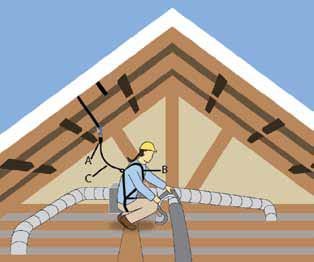OSHA Quick Card: Reducing Falls During Residential Construction: working in Attics
Protecting workers from falls while working in attics can be challenging for some employers. This fact sheet highlights some of the hazards of attic work and details some practical methods that employers can use to protect those who work in attics. The fall protection methods in this fact sheet may not be suitable in all situations. Employers are responsible for ensuring compliance with applicable OSHA requirements.
( Download: Ladder Inspection Forms )
You Can Read the OSHA Quick Card: Reducing Falls During Residential Construction by Flipping the book below :
Risk of Falls during Attic Work

Working in a low attic can be difficult. Employees moving through these spaces may be exposed to fall hazards at the openings between truss chords. Exposed nails, cables, wires, low-hanging rafters or cross beams, hot conditions, poor lighting, and truss chords hidden by deep insulation can add to the risk
of falling.
The employer must provide a training program for each worker who might be exposed to fall hazards.
The program must train each worker to recognize fall hazards and to know the procedures to follow to
minimize these hazards. For fall protection training requirements, refer to 29 CFR 1926.503. In all cases, employers must evaluate the hazards and take steps to reduce the risk of falls. Using appropriate fall protection measures reduces risks and saves lives.
Also, Read CAL/OSHA Scaffold Guide for safe use of supported Scaffolds )
Reducing Risks:
Planning
Planning for the use of fall protection equipment can help employers protect workers from falls. Before
beginning the job, identify fall protection needs. Survey the attic to determine what fall protection systems can be used. Plan ahead and have those systems in place before the workers report to the job. Determining Structural Integrity of Truss Chords or Ceiling Joists Workers can be injured if they fall through the ceiling to a lower level. Employers must determine if the walking/working surfaces in attics have the strength and structural integrity to support workers safely (29 CFR 1926.501(a)(2)). Only after this determination has been made should workers be allowed to enter those areas. Using a piece of plywood or planking to stand on could improve footing.
If the area around the plywood or planking is open, and the work area is 6 feet or more above a lower level, the employer generally must ensure that workers use fall protection meeting OSHA requirements (29 CFR 1926.501(b)(13)). Employers also may choose to use scaffolds or ladders for attic work.
(Note: OSHA’s fall protection requirements for residential construction work performed on scaffolds and ladders are specified in Subpart L and Subpart X, respectively, not in 29 CFR 1926.501(b)(13)).
Personal Fall Arrest System (PFAS)
A PFAS is a tool available to workers performing attic work. In fact, a PFAS is the system of choice for many workers who work at heights. However, a malfunction in any component of a PFAS could be disastrous for a worker. Always follow the manufacturer’s instructions on selecting, installing, and using PFAS components correctly. ( To complete the reading download the Card )
( Also Read: When Your Job Takes You to the Edge )
Download The Quick Card
OSHA Quick Card: Reducing Falls During Residential Construction: working in Attics
More Downloads
- OSHA Quick Cards: Aerial Lift Fall Protection over water in shipyards
- OSHA Quick Card: Reducing Falls During Residential Construction: working in Attics
- OSHA Quick Card: Portable Ladder Safety
- Programs: Stairways and Ladders A Guide to OSHA Rules
- Portable Ladder Self Inspection checklist







